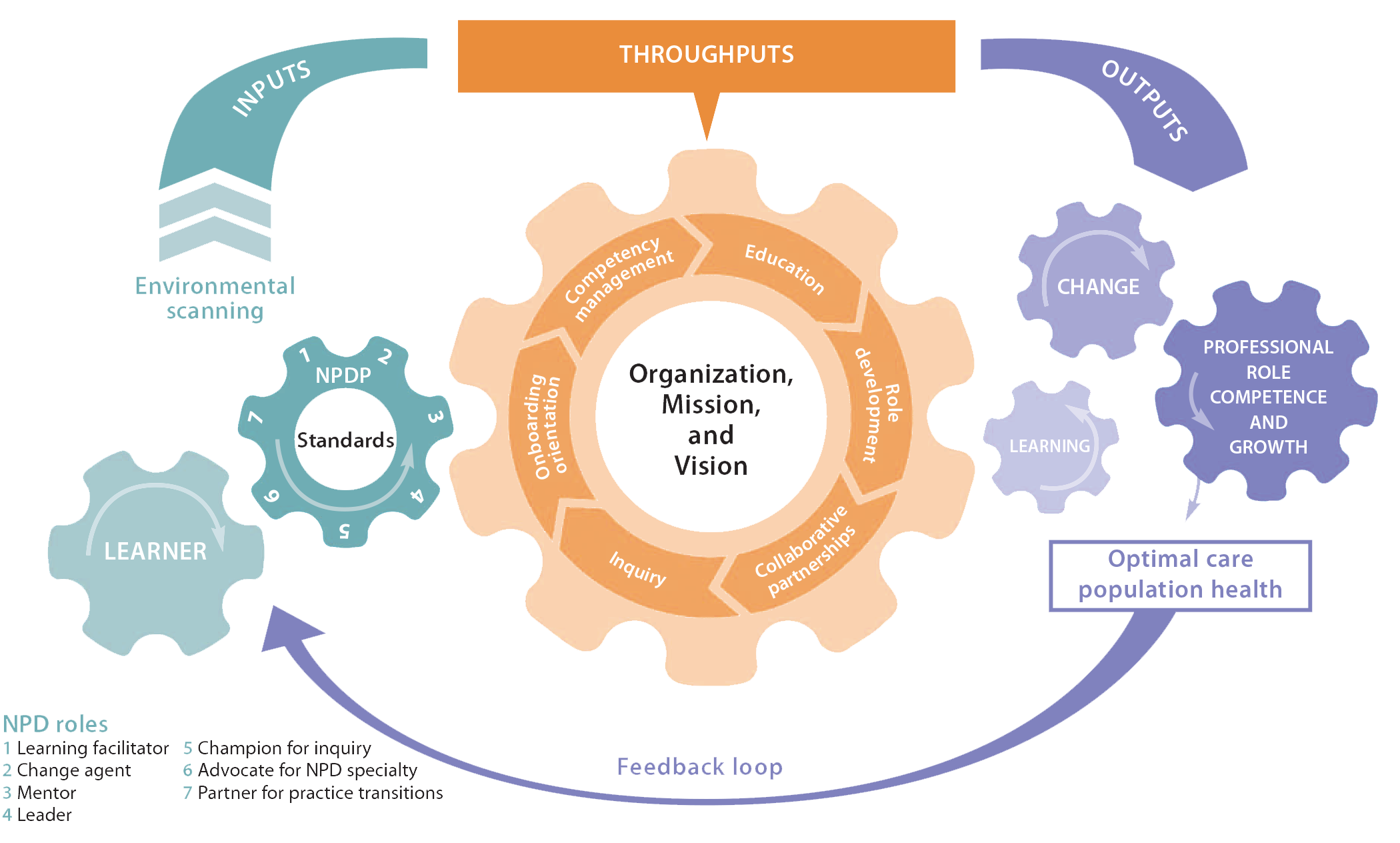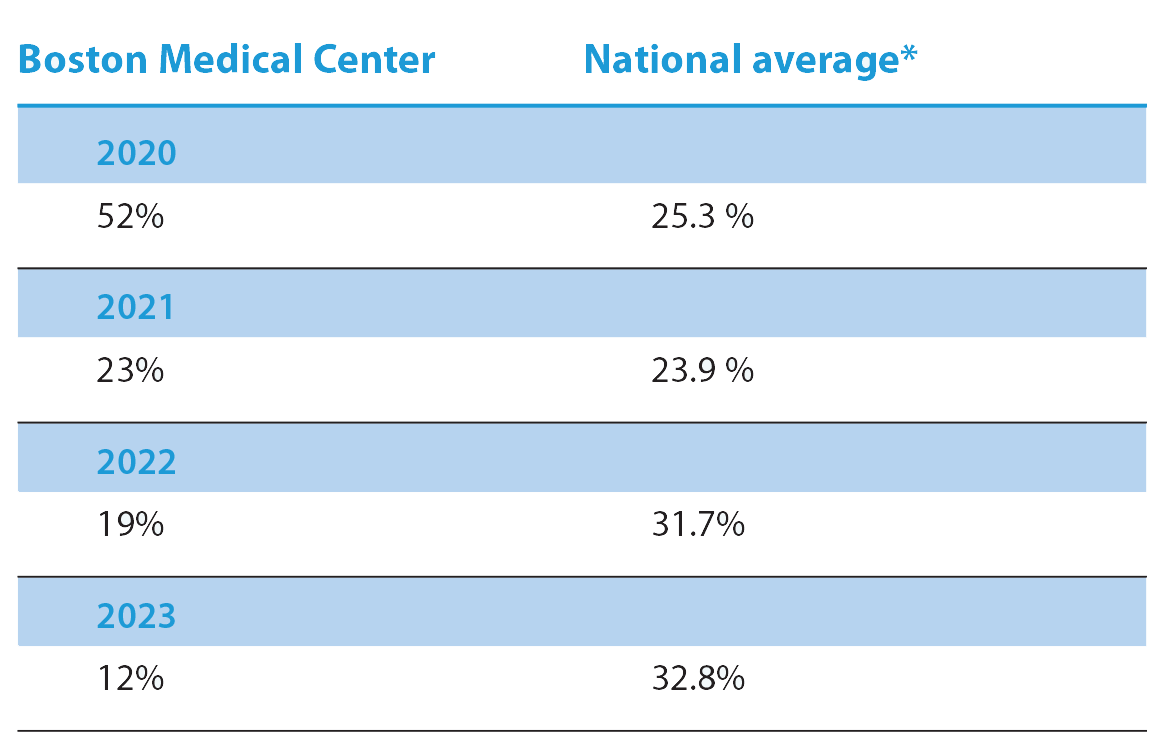An innovative approach to help new graduate nurses transition into practice
- As the nursing shortage continues, more new nursing graduates will take jobs in specialty areas such as critical care.
- Nursing graduates face many stressors and must be supported during their transition into practice.
- A nursing professional development practitioner at night program can help new graduate nurses’ transition into critical care and medical-surgical departments.
The Institute of Medicine advocates for well-prepared nurses to manage today’s complex healthcare environment. However, the nursing shortage presents a multifaceted and growing challenge. In an effort to address that challenge, Boston Medical Center (BMC) has implemented a nursing professional development (NPD) practitioner at night program to help new graduate nurses transition into critical care and medical-surgical units. Developed before the COVID-19 pandemic, the program has grown significantly over the past 5 years.
Our NPD practitioners work with new graduates to develop critical thinking skills that will help them address patients’ complex health needs. The NPD practitioners also promote unit socialization so new nurses feel accepted and secure, which can help reduce the chances that they’ll leave the organization. (See Cost of nurse turnover.)
What every nurse should know about staffing
Cost of nurse turnover
Heavy workloads and job stress heightened during the COVID-19 pandemic, which led to job burnout and contributed to the nursing shortage. In an attempt to address the shortage, hospitals paid hefty turnover costs associated with travel nurses and additional orientation classes.
According to the 2023 NSI National Health Care Retention and RN staffing report, the average hospital turnover rate remains elevated. The hospital turnover rate is 22.7% (3.2% decrease from 2021) and RN turnover is 22.5% (4.6% decrease from 2021). The average cost of turnover for a bedside RN is $50,000, resulting in the average hospital losing between $6 million and $10 million per year. The report adds that each percent change in RN turnover can cost or save the average hospital an additional $380,600 a year.
NPD practitioners and specialists
Maloney and Harper define NPD as a nursing practice specialty designed to improve the professional practice and role competence of nurses and other healthcare personnel by facilitating education and role growth to improve population health. NPD practitioners (generalists) have at least a baccalaureate degree in nursing without an NPD certification. As experts in their specialty (such as critical care), they serve as resources for new graduates. NPD specialists have a graduate degree and are certified in NPD. The term “practitioner” encompasses the generalist and the specialist. Typically, specialists oversee one main unit, whereas generalists assist with several areas. In most cases, generalists work under the guidance of a specialist.
Both specialists and generalists can function in leadership roles. Based on The Nursing Professional Development (NPD): Scope and Standards of Practice, Brunt and Bogdan outlined the following seven roles of NPD practitioners: learning facilitator, change agent, mentor, leader, champion for scientific inquiry, advocate for the NPD specialty, and partner for practice.
NPD practitioners support a culture of innovation, inquiry, and reflective learning. In addition to advancing a culture of innovation, the NPD specialist promotes organizational learning and continuous professional development. The NPD practitioner acts as a change agent in the interprofessional practice and learning environment, and the specialist leads change initiatives. (See NPD practice model.)
NPD practice model
The revised 2022 nursing professional development (NPD) standards include an updated systems practice model of inputs (environmental scanning, the learner, the seven NPD roles, and NPD standards) and throughputs (organizational mission and vision and six critical areas of responsibility: orientation and onboarding, competency management, education, role development, collaborative partnership, and inquiry).


New graduate stress
According to Reebals and colleagues, reasons for leaving nursing include workplace stress, high workloads, and poor staffing. New graduates face several specific stresses (especially in critical care), such as poor supervision, feelings of incompetence, inability to manage complex healthcare relationships, and poor time management skills. Flynn identified that critical care nurses have one of the highest rates of burnout, with 81% reporting burnout symptoms such as self-doubt, feeling helpless, decreased satisfaction and accomplishment, loss of motivation, and overall exhaustion. Stress is one of the primary reasons new graduates leave their jobs within the first 12 months of nursing practice.
Frequently, a new graduate’s expectation of their role requires better alignment with organization and leadership expectations. Kavanaugh and Sweda’s study found that only 23% of new graduate nurses were practice-ready (able to identify and manage a clinical change in status), 54% couldn’t manage a problem once identified, and only 23% could recognize the problem and act urgently.
Feeling supported can influence new graduates’ clinical competence and job satisfaction. BMC’s NPD practitioners help to foster a healthy work environment and encourage self-care. According to Walsh, a positive work environment aids a smooth transition for new nurses, which ultimately impacts patient care. The American Association of Critical-Care Nurses (AACN) states that a healthy work environment (adequate staffing, retention, reduced moral distress, and low rates of workplace violence) enables nurses to provide the highest standards of compassionate patient care while being satisfied at work. AACN highlights that nurse satisfaction with the profession has declined in the past 4 years, from 92% in 2018 to 76% in 2022. AACN also identified the following vital standards for healthy work environments: skilled communication, true collaboration, effective decision-making, appropriate staffing, meaningful recognition, and authentic leadership.
NPD structure and support
New graduate nurses require continual support and preparation to fulfill the complex roles associated with specialized areas such as critical care. At BMC (a level-one trauma center with 514 beds), the medical intensive care unit (ICU) nursing council identified a lack of support on the night shift for new nurses. As is typical in many healthcare organizations, most recent graduates start on the night shift, which can leave experienced nurses feeling overwhelmed as they try to support new nurses. BMC nursing leadership and frontline nurses suggested establishing expert nurses dedicated to supporting new graduates working night shift.
Initially, the grant-funded program for critical care and adult medical-surgical units was intended to be temporary and last for 6 months. The NPD practitioners covered approximately five out of the seven nights each week in the three central ICUs and the two progressive care units. The first cohort of new graduates consisted of 37 nurses for critical care.
Five years later, the NPD program has grown substantially and now encompasses many areas, including case management, pediatrics, maternity, post-anesthesia care, and the emergency department. The grant-funded temporary NPD practitioners (two in critical care and two in medical-surgical areas) are now in permanent positions and cover every night of the week.
Qualifications
We based the NPD practitioner qualifications on Benner’s novice to expert model, which states that nurses become experts over time and through experience. All of the organization’s NPD practitioners have the deep knowledge and experience to identify issues and take appropriate action. For example, the critical care NPD practitioners have a minimum of 20 years of experience; one has a doctorate in nursing practice, certification in education and critical care, and over 10 years of experience in academia; and two are pursuing their master’s degree, one in education and one in public health. They work closely with the NPD specialists (who typically are assigned to one unit) and nursing leadership.
Roles and responsibilities
The NPD practitioners foster critical thinking skills in new graduate nurses using Socratic questioning, assist with scaffolding activities (unfolding case studies), identify and clarify policies and procedures, role-model behavior, and support new graduates as they develop a sense of belonging. The practitioners also demonstrate caring behaviors, which include active listening, providing emotional support, and valuing new nurse contributions. They counsel new graduates about anxiety levels and explain that a healthy level of anxiety can aid focus. BMC offers interventions, including a licensed social worker and an employee assistance program, to address unhealthy anxiety. NPD practitioners remind new graduates that they’re never alone; they have access to several support layers, including resource nurses, fellow staff nurses, leadership, and the NPD practitioners and specialists.
Meetings among the NPD practitioners, NPD specialists and generalists, and nursing leadership occur routinely, and the specialists attend weekly education meetings. The NPD practitioners support all night staff with various education and safety initiatives, including the prevention of central line-associated bloodstream and catheter-associated urinary tract infections. They also help to reinforce and clarify the organization’s Weekly Top Five email, which provides information critical to all nursing staff.
In addition, the NPD team initiated Tuesday Night Trivia for the progressive care units. The trivia sessions focus on learning needs specific to these units and have become a team bonding experience. Nursing staff have noted that they appreciate having education come to them on their shifts. In a hospital education assessment survey administered to all nursing staff, respondents deemed night educators as “essential” and a “welcome support.”
The NPD practitioners organize and facilitate BMC’s night nursing council. At monthly night council meetings, the NPD practitioners, nurses, and a patient care experience representative work on projects that affect the overall patient experience. The current night council project, the Quietness at Night Campaign, has already improved the Hospital Consumer Assessment of Healthcare Providers and Systems scores from 54% in 2022 to 60.2% in early 2023.
Unexpected outcomes
New graduates, nursing leadership, experienced nurses, and NPD practitioners received an anonymous survey 1 year after program implementation. Of the initial 37 new graduates, 97.2% stated that the program should continue, and 91.36% of experienced nurses said that the program should continue and be offered in other departments. Although the NPD program is designed to assist new nurses in their transition to practice, feedback from experienced nursing staff indicated that they enjoy having a resource they can turn to for questions and to clarify policies and initiatives.
As with many healthcare organizations, BMC’s attrition rate of new graduates was up 52% during 2020. Travel nursing and the pandemic (BMC cared for more acute cases than any other hospital) accounted for much of this attrition. Many new nurses who chose travel nursing after less than 1 year of experience said that it offered them an opportunity to make money and pay off student loans. By 2022, BMC’s attrition rate decreased to 19%. For 2023, our attrition rate for new graduates remains promising and with lower rates anticipated. RN turnover in 2023 was 12%; however, similar to many institutions, our turnover rate remains highest in the 0 to 5-year tenure categories. (See Decreasing attrition.)
Decreasing attrition
The following table illustrates the decrease in new graduate attrition
at Boston Medical Center since the implementation of the nursing professional development program. (Many institutions don’t separate out 1-year new graduate RN turnover, which makes collecting accurate numbers difficult.)


*NSI Nursing Solutions, Inc. 2023 NSI National Health Care Retention & RN Staffing Report
We’ve also noted that many new graduates complete orientation earlier than expected. We didn’t monitor orientation completion, but we’re following it as our program continues.
Universal benefits
The nursing shortage will be around for the foreseeable future. Having NPD practitioners on our night shift has made some crucial impacts; however, it’s not a panacea. Currently, we’re developing projects to validate and measure critical thinking in new graduates, and we continue developing strategies for creating a sense of belonging and will launch a new graduate coffee hour. Consider implementing an innovative retention plan in your organization. Helping new nurses transition into practice benefits all of us.
The authors work at Boston Medical Center in Boston, Massachusetts. Jo Anne Foley, Jo Anne Rosato, Kristen O’ Malley Zetlan, and Tintra Monteiro are NPD generalists. Nicole Lincoln is senior manager of innovation.
American Nurse Journal. 2024; 19(2). Doi: 10.51256/ANJ022421
References
Almeida IF, Bernardes RA, Sousa LB, et al. Nursing professional self-concept: A scoping review protocol. Nurs Rep. 2023;13(1):51-6. doi:10.3390/nursrep13010005
American Association of Colleges of Nursing. Fact sheet: Nursing shortage. October 2022. aacnnursing.org/Portals/42/News/Factsheets/Nursing-Shortage-Factsheet.pdf
American Association of Critical-Care Nurses. Healthy work environments. aacn.org/nursing-excellence/healthy-work-environments
Brunt BA, Bogdan BA. Nursing professional development leadership. StatPearls. April 23, 2023. ncbi.nlm.nih.gov/books/NBK519064
Brunt BA, Russell J. Nursing professional development standards. StatPearls. September 20, 2022. ncbi.nlm.nih.gov/books/NBK534784/
Flynn J. 15+ nursing burnout statistics [2023]: The shocking truth about nursing. February 24, 2023. zippia.com/advice/nursing-burnout-statistics
Institute of Medicine Committee on the Robert Wood Johnson Foundation Initiative on the Future of Nursing, at the Institute of Medicine. The Future of Nursing: Leading Change, Advancing Health. 2011. 1. Key messages of the report. ncbi.nlm.nih.gov/books/NBK209881
Kavanagh JM, Szweda C. A crisis in competency: The strategic and ethical imperative to assessing new graduate nurses’ clinical reasoning. Nurs Educ Perspect. 2017;38(2):57-62. doi:10.1097/01.NEP.0000000000000112
Lake S. Travel nurse salaries are stabilizing in 2023 at about $3K per week. Fortune Education. February 17, 2023. fortune.com/education/articles/travel-nurse-salaries-are-stabilizing-in-2023-at-about-3k-per-week
Maloney P, Harper MG. Development of the nursing professional development scope and standards of practice. J Nurses Prof Dev. 2022;38(2):109-12. doi:10.1097/NND.0000000000000851
NSI Nursing Solutions, Inc. 2023 NSI National Health Care Retention & RN Staffing Report. nsinursingsolutions.com/Documents/Library/NSI_National_Health_Care_Retention_Report.pdf
Reebals C, Wood T, Markaki A. Transition to practice for new nurse graduates: Barriers and mitigating strategies. West J Nurs Res. 2022;
44(4):416-29. doi:10.1177/0193945921997925
Sandler M. Why are new graduate nurses leaving the profession in their first year of practice and how does this impact ED nurse staffing? A rapid review of current literature and recommended reading. Can J Emerg Nurs. 2018;41(1): 23-4. doi:10.29173/cjen66
Quinn B. Using Benner’s model of clinical competency to promote nursing leadership. Nurs Manag. 2020;27(2):33-41. doi:10.7748/nm.2020.e1911
Tanner CA. Thinking like a nurse: A research-based model of clinical judgment in nursing. J Nurs Educ. 2006;45(6): 204-11. doi:10.3928/01484834-20060601-04.
Walsh AL. Nurse residency program and the benefits for new graduate nurses. Pediatr Nurs. 2018;44(6):275-9.
Key words: new nurse graduates, new nurses, nurse professional development, nursing shortage



















1 Comment. Leave new
This is very insightful to my role as night educator, it gives me a broader perspective as to how to I will improve my goals and implement new projects.